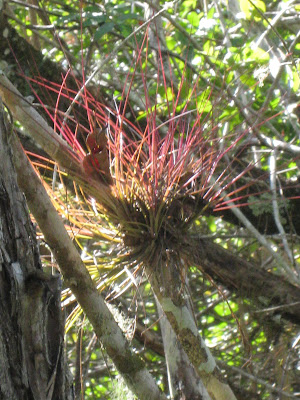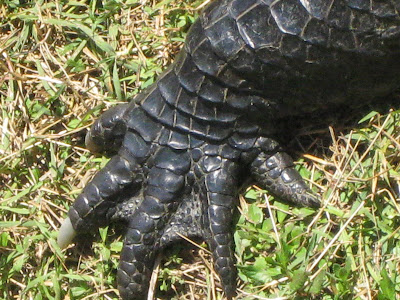I recently realized that I have used some of Linda's pictures without giving her due credit. I went back through and noted with an "LJM"any pictures on the blog that she took. She uses a pocket Canon PowerShot digital Elph camera that takes as sharp an image as our old Nikon. Kudos and Thanks, Linda.

 We were wishing we had something, or someone, next to this big guyin order to have a contrast for his size. However, no one would volunteer to step off the boardwalk. LJM
We were wishing we had something, or someone, next to this big guyin order to have a contrast for his size. However, no one would volunteer to step off the boardwalk. LJM

 This poor bird only had one foot. It looked well healed, so I guess he is a survivor
This poor bird only had one foot. It looked well healed, so I guess he is a survivor
Friday we went to Lover's Key State Park near Fort Myers. It was a cool sunny day, so we dressed in layers, packed a lunch, and met the Burwell's there at noon. The beach was wind free and loaded with shells so we spread out our blankets and spent a couple of hours lounging in the sun and searching for more shells to bring home.
Florida has an extensive collection of State Parks that give access to many of the State's diverse habitats and wild life. We are trying to ignore the traffic and sprawl that covers most of Florida and concentrate on it's natural history and beauty.
Collier-Seminole State Park is about an hour south of Naples. During the 1920s an early developer, Barron Collier, purchased almost a million acres in southern Florida. Collier was a major investor in developing the western section of the Tampa to Miami highway, now known as the Tamiami Trail. The park has on display the only remaining "Walking Dredge" that was used to create the roadbed for the Tamiami Highway. The dredge piled up the rocks and mud after the limestone base had been blasted apart. Workers then used the material as a solid foundation for the road being created through the middle of this shallow swamp.
In 1923 the large land area in south Florida became Collier County and a park was created to protect the Royal Palm trees that grew here. It is one of only three places in this State where the Royal Palm tree originally grew. These are the tall, thin, gray cement-color palms, where the upper third of the tree changes to a smooth soft green before branching into the traditional palm fronds.
Barron Collier donated the Park area to the County to serve as a memorial to himself and those who fought on both sides of the three Seminole Wars. In 1947 the County donated the land to the State of Florida and it became Collier-Seminole State Park.
We walked on the Royal Palm Hammock Trail, which has informative signage throughout its length. After our walk we found a sunny table and had a picnic. Meanwhile, the wind had been steadily increasing and by the time we finished eating, broken palm fronds were whipping across the grass fast enough to cause damage if you got in their path. We planned to come back next week and do the guided canoe trip along the Blackwater river, which travels through the ever- present mangrove forest.
Collier-Seminole State Park is about an hour south of Naples. During the 1920s an early developer, Barron Collier, purchased almost a million acres in southern Florida. Collier was a major investor in developing the western section of the Tampa to Miami highway, now known as the Tamiami Trail. The park has on display the only remaining "Walking Dredge" that was used to create the roadbed for the Tamiami Highway. The dredge piled up the rocks and mud after the limestone base had been blasted apart. Workers then used the material as a solid foundation for the road being created through the middle of this shallow swamp.
In 1923 the large land area in south Florida became Collier County and a park was created to protect the Royal Palm trees that grew here. It is one of only three places in this State where the Royal Palm tree originally grew. These are the tall, thin, gray cement-color palms, where the upper third of the tree changes to a smooth soft green before branching into the traditional palm fronds.
Barron Collier donated the Park area to the County to serve as a memorial to himself and those who fought on both sides of the three Seminole Wars. In 1947 the County donated the land to the State of Florida and it became Collier-Seminole State Park.
We walked on the Royal Palm Hammock Trail, which has informative signage throughout its length. After our walk we found a sunny table and had a picnic. Meanwhile, the wind had been steadily increasing and by the time we finished eating, broken palm fronds were whipping across the grass fast enough to cause damage if you got in their path. We planned to come back next week and do the guided canoe trip along the Blackwater river, which travels through the ever- present mangrove forest.


of its red peeling bark. LJM
plants called bromeliads, that get their nutrients from wind blown dust and leaf debris that fall
on them.

swamps that make up Southern Florida.
After lunch we drove about 30 miles east to the Oasis visitors center at Big Cypress National Preserve. This 2,400 square miles of swamp, just north of the Tamiami Trail, is the major source of water for the Everglades and provides a sanctuary for wildlife that includes the endangered Florida Panther. While here we saw an enormous alligator. The ranger said he was at least 50 years old and looked to be about 12 to 14 feet long. As alligators age, they get wider rather than longer and this one was pretty stout. I used all Linda's pictures from here, since our camera was left in the car.
 We were wishing we had something, or someone, next to this big guyin order to have a contrast for his size. However, no one would volunteer to step off the boardwalk. LJM
We were wishing we had something, or someone, next to this big guyin order to have a contrast for his size. However, no one would volunteer to step off the boardwalk. LJM
Is he snoring?
 This poor bird only had one foot. It looked well healed, so I guess he is a survivor
This poor bird only had one foot. It looked well healed, so I guess he is a survivorFriday we went to Lover's Key State Park near Fort Myers. It was a cool sunny day, so we dressed in layers, packed a lunch, and met the Burwell's there at noon. The beach was wind free and loaded with shells so we spread out our blankets and spent a couple of hours lounging in the sun and searching for more shells to bring home.
Back in the 60's and 70's, Black Island, which is part of Lover's Key, was slated for development and dredging destroyed most of the mangroves and created extensive canals. In 1983 the State of Florida acquired the island and has planted native plants along a 2 1/2 mile trail in an effort to recreate the original maritime hammock.
Again we found a pleasant walking trail with well-marked and interesting plants. This walk included a unique osprey sighting along one of the canals. A single osprey was sitting high in a dead tree with a large fish in its talons, being watched by two turkey vultures. While we looked on, two additional osprey circled overhead, calling out with their shrill screech. After several circles, one flew near the tree but did not land. This bird had a small fish in its talon. Maybe they were comparing the day's catch. After awhile the two fliers left, the one in the tree began to eat the large fish. The vultures never took their eyes off of the bird in the tree. I don't think they were going to get any leftovers but they were willing to wait it out.
















No comments:
Post a Comment